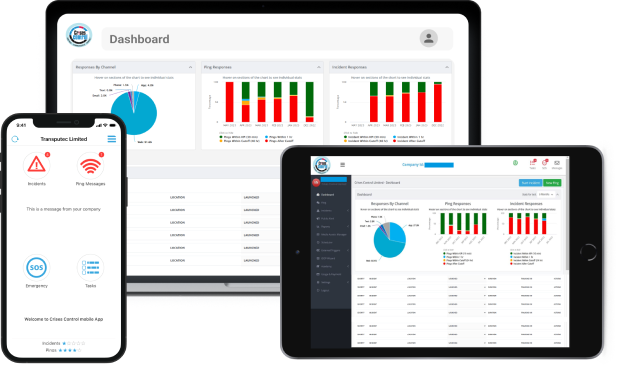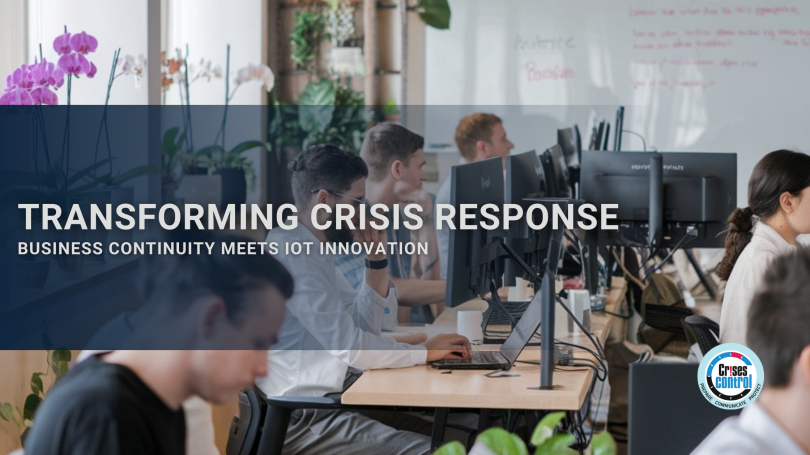Written by Ikram Tassi | Marketing
Disruptions can occur at any moment—whether it’s a natural disaster, a security breach, or an unexpected operational failure. How your business responds to these crises can significantly impact its ability to recover. In the past, companies often found themselves scrambling to address crises after they occurred. However, with modern Business Continuity Software (BCS), organisations can take a proactive approach, ensuring minimal downtime and continued operations even in the face of major disruptions.
The next evolution in crisis management is the integration of IoT devices with your business continuity software. This technology allows businesses to monitor critical systems in real time, predict potential threats, and automate responses—empowering managers to make fast, data-driven decisions when it matters most.
At Crises Control, we specialise in equipping businesses with a comprehensive Business Continuity Platform that leverages IoT integration to ensure quick, effective, and seamless crisis management. In this blog, we’ll explore how integrating IoT with your crisis management strategy can help you manage risks smarter, reduce downtime, and safeguard your operations.
What Is Business Continuity Software and Why Is It Critical?
In simple terms, Business Continuity Software helps ensure your organisation can maintain essential operations during a crisis. It provides structured plans and systems for handling disruptions, enabling teams to respond swiftly and minimise the impact.
Crisis management used to focus on having a solid plan in place for when things went wrong. However, with the rise of digital technology and IoT, the focus is now shifting towards proactive management—anticipating problems before they occur and taking action immediately to prevent further damage.
IoT integration with Business Continuity Software makes it possible to monitor systems, track environmental conditions, and receive real-time alerts—all of which are essential for making smart decisions during a crisis.
How Does IoT Enhance Crisis Management?
IoT refers to the network of physical devices—such as sensors, cameras, and tracking systems—that collect and transmit data about various aspects of your business environment. When integrated with Business Continuity Software, IoT devices provide actionable insights that allow organisations to predict and respond to crises more effectively.
Here are some ways IoT makes crisis management smarter:
- Real-Time Monitoring: Constantly monitor critical operations to catch potential threats as soon as they emerge.
- Predictive Alerts: IoT sensors help predict issues before they happen, allowing teams to act before a problem becomes a crisis.
- Automation of Responses: Set up automated workflows that respond to alerts in real time—minimising manual intervention and improving response speed.
- Improved Communication: Share real-time data with key stakeholders through your Business Continuity Platform, ensuring everyone is on the same page when a crisis hits.
How Crises Control Enhances Crisis Management with IoT Integration
At Crises Control, we take the integration of Business Continuity Software and IoT devices to the next level. Our platform seamlessly connects to a variety of IoT devices, providing a centralised view of your operations. By integrating real-time data from these devices, our platform empowers businesses to react faster and more effectively in crisis situations.
Let’s take a closer look at how Crises Control enhances crisis management through IoT:
1. Seamless IoT Integration
Crises Control integrates effortlessly with your existing IoT infrastructure. Whether you’re monitoring temperature, security systems, or equipment health, our platform pulls data from all your devices into one central system. This gives you a complete picture of your operations, making it easier to track potential risks and make informed decisions.
2. Real-Time Alerts and Notifications
When a crisis is unfolding, every second counts. Crises Control ensures that the right people are notified immediately with real-time alerts. Whether it’s a fire alarm, a security breach, or a system failure, our platform sends out instant notifications through multiple channels (email, SMS, push notifications, voice calls and web alerts) to ensure that your team can act quickly.
3. Data-Driven Decision-Making
IoT data provides actionable insights that inform decision-making. With Crises Control, your team can make data-driven decisions based on the most current and accurate information available.
4. Automating Crisis Responses
One of the biggest challenges during a crisis is the speed of response. Crises Control takes care of this by automating many processes based on real-time data. For instance, if an IoT sensor detects an overheat in machinery, the system can automatically shut down the equipment to prevent further damage, while simultaneously alerting relevant teams to the issue.
5. Centralised Crisis Management Dashboard
Crises Control’s user-friendly dashboard centralises all data from your IoT devices and crisis response efforts. This means you can access real-time information on your entire operation, from environmental conditions to employee safety, all in one place. It helps you make quick, informed decisions during a crisis.
The Real Benefits of Business Continuity Software with IoT Integration
The combination of IoT and Business Continuity Software offers far-reaching benefits for organisations in crisis management. Here’s why it’s a game-changer:
1. Quicker Response Times
Real-time monitoring and alerts mean your team can respond immediately to emerging issues. Whether it’s an equipment failure or a natural disaster, your crisis management team can act before the situation worsens. This reduces the impact of the crisis and accelerates recovery times.
2. Better Risk Prediction and Prevention
IoT sensors continuously monitor your operations, allowing you to predict potential disruptions. If equipment is showing signs of wear or a change in environmental conditions could lead to a threat, you can intervene early to prevent a crisis.
3. Reduced Downtime
With faster response times and better risk prevention, you’ll experience less downtime during and after a crisis. This minimises disruption to your operations and keeps your business running smoothly.
4. Cost Savings
By preventing costly mistakes, reducing downtime, and improving crisis response, businesses can save significant amounts of money. IoT also allows for better resource management, ensuring that assets are allocated effectively during a crisis.
5. Increased Resilience
Businesses that embrace IoT and business continuity software are better equipped to handle crises and bounce back quickly. This proactive approach to crisis management builds long-term resilience, ensuring your business can weather any storm.
Crises Control: Your Partner in Business Continuity
At Crises Control, we believe that effective crisis management goes beyond just having a plan. It’s about having the right tools to make real-time, data-driven decisions when disaster strikes. By integrating Business Continuity Software with IoT devices, our platform helps organisations become more resilient and responsive to crises.
Whether you’re looking to monitor your environment, automate crisis response, or improve communication during emergencies, Crises Control offers everything you need to enhance your crisis management strategy.
Conclusion: Ready to Improve Your Crisis Management?
In today’s unpredictable world, every second counts during a crisis. With the integration of Business Continuity Software with IoT, you can take a proactive approach to crisis management, making smarter, faster decisions that protect your business and help it recover more efficiently.
Crises Control helps businesses like yours integrate IoT devices seamlessly into their crisis management strategy, ensuring that you’re always prepared, no matter what. Don’t wait for a crisis to test your plans—start using the tools that will keep your operations resilient, even when the unexpected happens.
Ready to take your crisis management to the next level? Contact us today for a free demo and see how Crises Control can help your business stay resilient, no matter what.
Request a FREE Demo

